
Brian Evans
-
Posts
75 -
Joined
-
Last visited
Content Type
Profiles
Forums
Articles
Gallery
Downloads
Events
Posts posted by Brian Evans
-
-
Friday unfortunately is the soonest I can go.
-
Thanks guys, I planning on getting it if it tests well. I was unexpectedly called in to work today so I was unable to go and see it today. I am going on Friday now.
-
-
-
I personally wouldn't spend much more than 200 USD on that anvil I estimate it between 50 and 80 lbs (if it weighs more it would be worth more), but again I am not the best person to appraise the value of the anvil.
If you do decide to pursue this anvil further I have some recommendations:
Test the bounce with a smaller hammer (the more bounce it has the better of an anvil it is, usually cast iron does not have the best bounce, to do this you take a smaller sized hammer and pinch the end of the handle and let it drop onto the anvil so it swings by force of gravity)
when you do the bounce test make sure that you can live with hearing that noise a lot (From what I understand Columbian anvils can be loud)
Make sure that there are no fractures or cracks in it anywhere especially in the area where the face plate is welded onto the body of the anvil (cast iron can be brittle)
if you decide to get it do not grind on the face plate of the anvil even if there are dents and divots, it will wear down eventually.
If money is tight I would recommend finding an ASO (anvil shaped object) this is a large chunk of steel that has a flat face and good rebound.
-
9 minutes ago, Shanda said:
Thanks for the welcome! It is a Columbian anvil and that is about all I happen to know...unfortunately!
Someone here seems to think that is a good brand.
The one you show seems to be on the smaller side and the stand seems pretty tall and I cant see any way to adjust the height. You usually want the face of the anvil a height between your knuckles and your first joint on your finger. So keep in mind you may have to change the stand.
-
I am not the most knowledgeable person on anvils here by far. But I think unless someone recognizes the makers mark we need more information to go off of in order to give an accurate estimate. Do you have any other information on the anvil? Perhaps a weight? Brand? Serial Number, if you are lucky?
It looks like the body of the anvil is cast iron and the face is plate steel welded on.
-
Might be a bit late to the party, but I recently caved and bought wheel sets from them. I got the 4 inch 3/4 bore aluminum drive wheel and the 3 wheel set made of seemingly high quality plastic and bearings. I have yet to try them out but on inspection they seem to be worth the money. (especially since I tried to make my own wheels and failed miserably)
-
37 minutes ago, JustAnotherBiker said:
Would likely be less dangerous and a less stressful working life too.
That is true but I wouldn't be able to leave after 25 years with a state pension if I worked as s spring blacksmith.
-
Hey guys I am not sure where to put this if this is not the place please move it to the correct place.
My problem is with where I want to go with my life in regard to jobs. I have been preparing to work in law enforcement for several years and have been expecting to do that for longer. However I have been looking into getting a job as a blacksmith because I love working with metal so much. I may have an opportunity to be a spring blacksmith, the problem is it is several years of training. After the guy who trains me retires I would be the only one that can do this job for the rest of my career.
I want to know what you guys would do.
Confucius said "Choose a job you love, and you will never have to work a day in your life."
-
Thanks for the help guys, I modified the design to add another wheel and a spring.
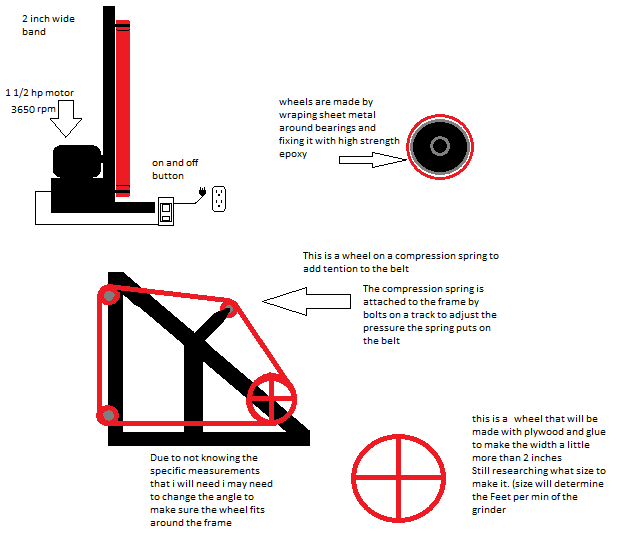
-
39 minutes ago, Jonnytait said:
I kind of like this hammer, have you tried forging with it yet?
Yes I have, It works very well. I may test adding more weight or another spring to make the impact stronger.
I used the general design from this guys power hammer
-
19 hours ago, Irondragon Forge & Clay said:
What are you planning to use for the belt tension? Didn't see anything in the diagram.
I was planning on using the motor mount be adjustable via tracks nuts and bolts, it would also be the way to change out belts. Depending on what I need for tension I need I may attach a compression spring to a wheel if the motor mount adjustment is not enough.
18 hours ago, RogueGeek said:I'm using a 1-1/2 hp motor. It does a decent job but I can bog it down if I really try to. I don't think a 1/2hp motor will be useful for anything other than just watching the belt go around.
Edit to add:
Check and see if you have a welding school near you. The one my daughter is going to will take on projects for people at very reasonable costs.I will be using a 1 1/2 hp motor, I have since revised a few factors since posting the design.
Unfortunately the welding school near me has bad times of their classes and they are more than I can spend. I am trying to keep costs down by making things with what I have.
-
Power hammer is finished and there are no problems so far after a few tweaks were made. The joints from the motor shaft are a kind of notched scarf joint covered with tape and clamped together.
My next step is to adjust the head so I can change it out easily.
-
Ok I am getting a better idea of what I should be looking for when I am building it. I may end up adding a three step pulley to the design later if I need to. For now I want something that doesn't take as long as a hand file. I am going to have my drive wheel 5 and a half inches in diameter.
-
Buzzkill so you have your grinder that goes a little more than 2093 sfpm
I guess i will try something similar and have a 4-5 inch wheel
-
1 minute ago, Steve Sells said:
those are partially dependant on bearings and belts
Can you expand on that? I was under the impression that there would be an ideal speed to grind steel (probably different for each type of steel), apparently I am wrong. I am here to learn.
I was going to have the motor shaft directly attached to the grinding belt wheel. I need to know what SFPM to make it before i can determine the size of the wheel.
-
4 hours ago, Buzzkill said:
Good luck with whatever you choose to do, but please understand that when you ask for opinions/tips, the ones you get may not line up with what you had planned.
oh I am well aware of that. But that is something I prepared for, I have not yet started the project aside from acquiring pieces and gluing plywood together for the wheel.
I appreciate all the help and suggestions. I am now going to make it a 72 inch belt design and I have salvaged a 1 and 1/2 horse motor off my table saw that I have not used since I have started to make things in the shop. I am going to make the frame out of wood for several reasons: I would have to find all the metal pieces in a scrap yard or buy them, I do not have an efficient way to cut metal (4 inch angle grinder that heats up way to fast), and the power hammer that I made out of wood has had no issues (so far, probably with around 40 hours of use). If this decision ends up being a mistake then that is on me.
I still have not been able to find a speed (SFPM) that is recommended for grinding blades does anyone have an idea?
17 hours ago, ThomasPowers said:Can you explain how spending $4.66 per belt saves money over spending $2 per belt for belts that will last longer as well? If you want to do blades on it you will be buying belts by the 10 pack not just 6...When I worked for a swordmaker making high end blades---$7000 in 1980's dollars! He said one of the secrets was to use belts as if they were free as trying to get the last bit of work out of a used belt often ended up causing issues that would have paid for big stack of new ones----for example fresh belts cut cooler with less force!
I did not know that fresh belts cut cooler, that is good to know. When you worked for a swordmaker what was the SFPM of the grinder that you used?
By the way Steve Sells did convince me to move to a 72 inch.
-
52 minutes ago, NickOHH said:
What kind of motor is it that your using a fan speed controller? Going to lose torque like crazy
Do you suggest I have no speed adjustment in the grinder? I figured that the fan speed controller was a cheap way of doing that.
-
8 minutes ago, Steve Sells said:
i think you missed my point about belts and availability I was talking about choices in grit and materials
I am having a harder time finding the selection in 2x72 than I am in 2x42. A brief look at the assortment I see numerous options anywhere between 40 and 800 grit in the 2x42 size. Im not trying to argue with you.
https://www.amazon.com/Knife-Makers-Sanding-Belts-Assortment/dp/B01FIJMO2O
if you look at the product and the similar products you can see a lot of options.
-
10 minutes ago, Steve Sells said:
Why 2x42 inch? Have you researched the belt sizes and availability? I suggest you stop building and read a bit more about motor sizes and belt sizes, most suggest at least 1hp with 2 hp being ideal, and if you look around will notice few belt options for your chosen size, whereas 2x72 inch is the standard and has many options for about the same work to build
42 inch belts are just as easy as any other ones for me to get thanks to the internet. I have not started to build yet I am making the plans first. I unfortunately only have access to a 1/2 hp motor. If I need to upgrade later to a larger motor that shouldn't be a problem. Maybe ill steal the one from my table saw... it is a 2 hp and I haven't used it in well over a year
-
Here is a design for a 42 inch belt grinder. This is my general design but there are no measurements, I plan on doing the measurements when I have the 42 inch belt so I can use it to see what I need exactly.
The frame is to be made of 2x4s
I do not have a welder available to me.
Questions: What feet per min should I have for the highest setting?
How strong does this need to be? I wouldn't think a 1/2 horse motor would put a lot of stress on it.
Any tips? I haven't made one of these before.
thank you
-
On 10/8/2017 at 10:04 PM, Nobody Special said:
Most rail is welded, but jointed track will have a fishplate on it.
Here is an image of one of the pieces. It weighs aroun 30-40 pounds (maybe more). Is this the piece you are meaning? I also have square plates that each have 4 holes in them of varying sizes that came from the same area where the railroad scrap came from.
It has a very similar sparking to railroad tracks but not exactly the same. It actually took me longer to cut through a piece than it took for me to cut through a railroad track.
-
Easiest way to test your guess would be spark testing the connector and a piece of rail and compare them.
I completely forgot about that. I guess problem solved, Thanks!
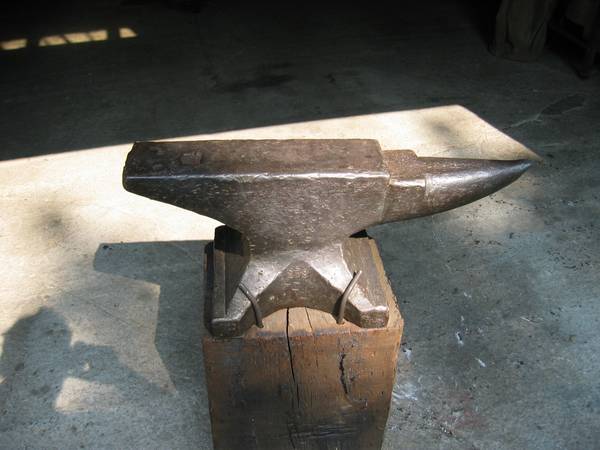
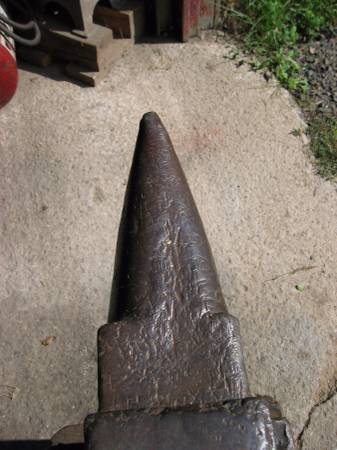
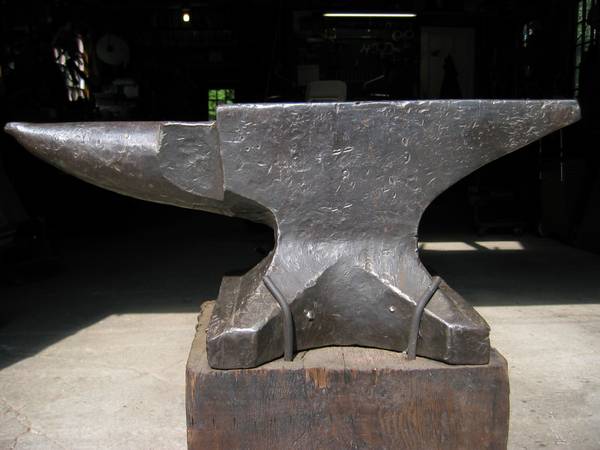
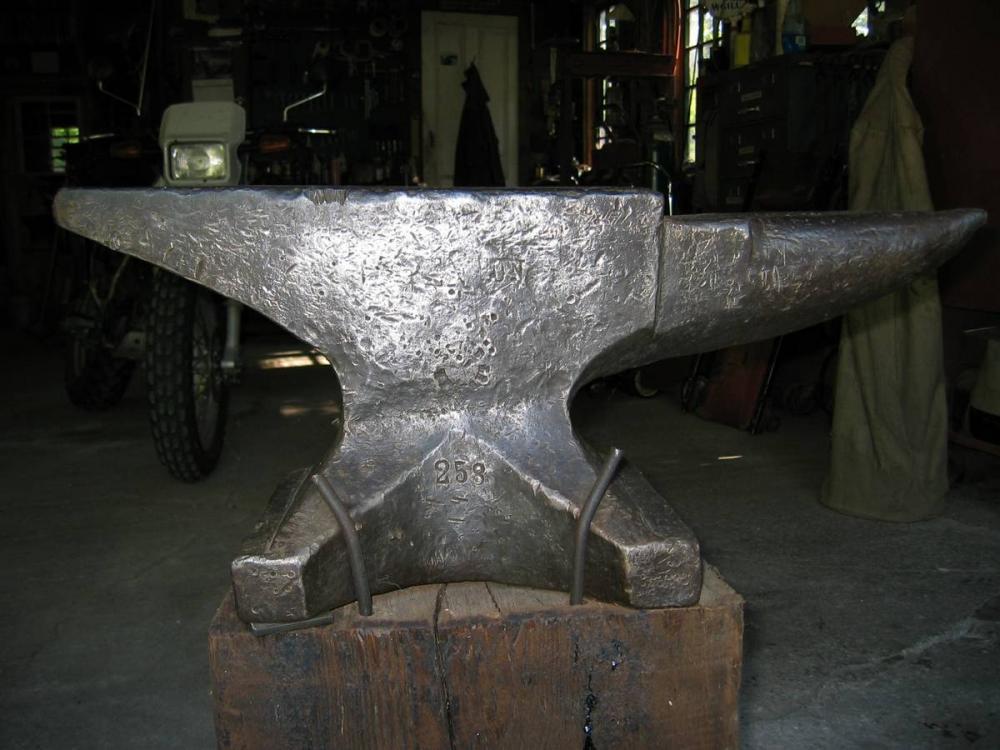
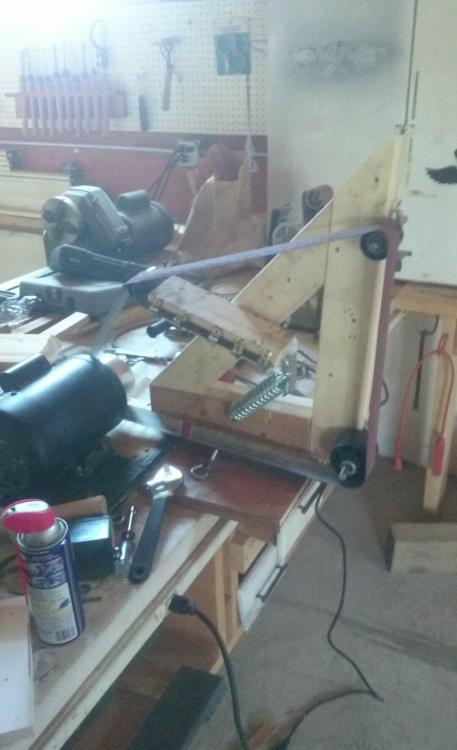
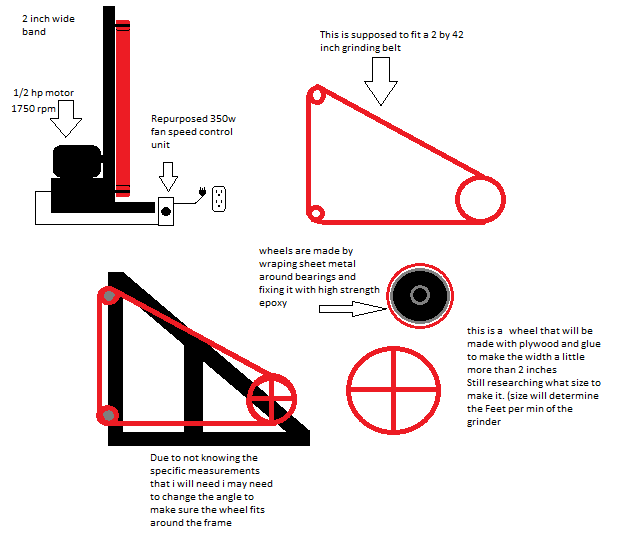
looking for trenton 258 information
in Anvils, Swage Blocks, and Mandrels
Posted
I got it for $400 it has a small hole in one side of the face but other than that it tests very well and is quiet. The hole does not go all the way through the face plate and there are no signs of cracks.